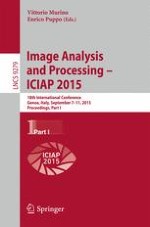The two-volume set LNCS 9279 and 9280 constitutes the refereed proceedings of the 18th International Conference on Image Analysis and Processing, ICIAP 2015, held in Genoa, Italy, in September 2015. The 129 papers presented were carefully reviewed and selected from 231 submissions. The papers are organized in the following seven topical sections: video analysis and understanding, multiview geometry and 3D computer vision, pattern recognition and machine learning, image analysis, detection and recognition, shape analysis and modeling, multimedia, and biomedical applications.
